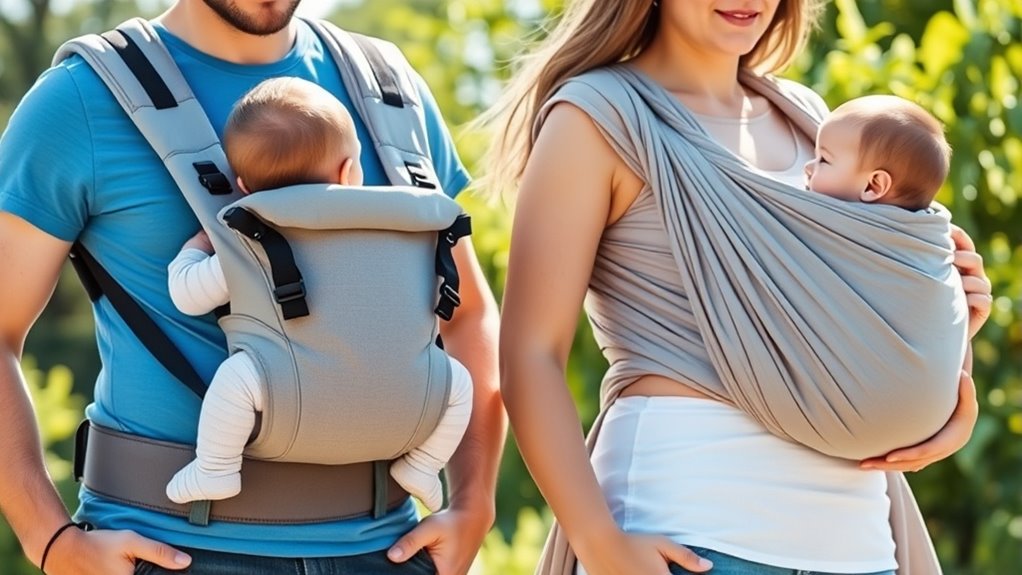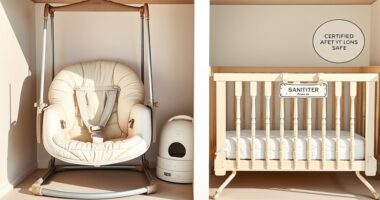Baby carriers and slings each have unique strengths. Carriers offer adjustable, ergonomic support for both your back and your baby, making them ideal for extended, active use. Slings are soft, simple, and great for quick, short outings, providing closeness and comfort. If you want long-term support and versatility, a carrier works best. For convenience and brief use, a sling is perfect. Keep going to discover which option suits your lifestyle best.
Key Takeaways
- Baby carriers offer ergonomic support with adjustable straps and multiple positions, ideal for extended wear and active lifestyles.
- Slings are soft, lightweight, and easy to put on, suitable for quick, short trips and close cuddling.
- Carriers are made from durable materials designed for long-term use, while slings use softer fabrics that may wear faster.
- Carriers provide better weight distribution and spinal alignment for both caregiver and baby, reducing strain.
- Slings are best for brief, casual outings, whereas carriers suit daily, prolonged carrying needs.

When choosing a way to carry your baby, understanding the differences between baby carriers and slings can help you make an informed decision. Both options are popular for keeping your little one close, but they serve different needs and preferences. A key factor to consider is ergonomic support. Baby carriers typically offer structured designs that distribute your baby’s weight evenly across your hips and shoulders. This design promotes proper spinal alignment and reduces strain on your back, making long-term carrying more comfortable. Slings, on the other hand, tend to mold more closely to your body, which can be cozy for your baby but may not always provide the same level of ergonomic support. If you plan on carrying your baby for extended periods, a well-designed carrier might be the better choice to prevent discomfort and guarantee your child’s healthy development. Additionally, understanding layer concepts can inform the selection of materials and design features that enhance support and durability in your chosen carrier. Fabric durability is another vital aspect to consider. Baby carriers are often made from sturdy, reinforced materials like cotton, canvas, or mesh, ensuring they withstand daily wear and tear. These fabrics are designed to hold your baby’s weight securely over many months, maintaining their shape and support. Slings, usually crafted from softer, stretchier fabrics like silk, linen, or blended textiles, offer flexibility and closeness but may wear out faster with frequent use or washing. While soft fabrics enhance comfort and ease of use, they might not be as long-lasting as the more durable materials used in traditional carriers. If you’re looking for a carrier that can endure active lifestyles and regular use, investing in a high-quality, durable fabric carrier could prove more cost-effective over time. In terms of versatility, baby carriers often include adjustable straps and multiple carrying positions, allowing you to customize fit and comfort as your baby grows. They’re generally more supportive for back and hip health, especially with ergonomic designs. Slings usually offer a more straightforward, quick-to-wear option, enabling you to slip your baby in and out easily. However, their simplicity sometimes limits the variety of positions you can carry your baby in, which could affect comfort or safety depending on your baby’s age and size. Ultimately, your choice depends on your lifestyle and preferences. If you prioritize ergonomic support and durability for regular, extended carrying, a structured baby carrier might be the best fit. If you prefer something lightweight, quick, and cozy for short trips, a sling could suit you better. Both have their advantages, but understanding these core differences helps you pick the option that aligns with your needs and keeps both you and your baby comfortable and secure.
Frequently Asked Questions
Are Baby Carriers Suitable for Newborns?
Yes, baby carriers are suitable for newborns if they offer proper newborn support and have an ergonomic design. Look for models that provide adequate head and neck support, ensure the baby’s hips are in a healthy position, and are adjustable for a snug fit. Using the right carrier keeps your newborn comfortable, close, and secure while promoting healthy development and making it easier for you to carry them safely.
Can Slings Be Used for Hiking or Outdoor Activities?
Sure, slings can be used for hiking, but don’t expect them to magically distribute weight evenly or handle rough terrain. As you climb, your sling’s fabric might slip, and weather considerations like rain or sweat could turn your outing into a soggy mess. For outdoor adventures, a sturdy baby carrier with proper weight distribution is smarter—your back and your little one will thank you!
How Do I Choose the Right Size for a Carrier or Sling?
To select the right size for a carrier or sling, start by measuring your chest or waist, depending on the product type. Consider fabric materials—sturdy, breathable fabrics like cotton or linen work well. Check weight limits to make certain it supports your baby’s size and weight comfortably. If you’re between sizes, opt for the larger one for comfort and flexibility, ensuring your baby stays secure without feeling cramped.
Are Baby Carriers or Slings Safer for Extended Wear?
Think of your baby’s comfort as a delicate garden needing careful nurturing. Both carriers and slings can be safe for extended wear if you prioritize ergonomics concerns and material safety. Look for breathable fabrics and proper support to prevent strain on your back and hips. With correct positioning and regular breaks, you can confidently wear your baby longer, ensuring their safety and your well-being grow together, like a thriving plant.
Do Both Options Support Breastfeeding Convenience?
Both baby carriers and slings can support breastfeeding convenience, but slings often provide easier nursing support because they allow quick access and close contact. With a sling, you can comfortably nurse your baby while remaining hands-free, making nursing more discreet and convenient. Baby carriers also support breastfeeding, but they might require more adjustments. Choose the option that best fits your comfort and nursing needs for better breastfeeding support and nursing convenience.
Conclusion
Choosing between baby carriers and slings depends on your needs, but both are like trusty companions that keep your little one close. Carriers offer more support for longer wear, while slings provide quick, easy access. Think of them as different tools in your parenting toolbox—each perfect for specific moments. Whichever you pick, it’s about finding what feels right for you and your baby, creating a bond as natural and essential as the sunrise.








